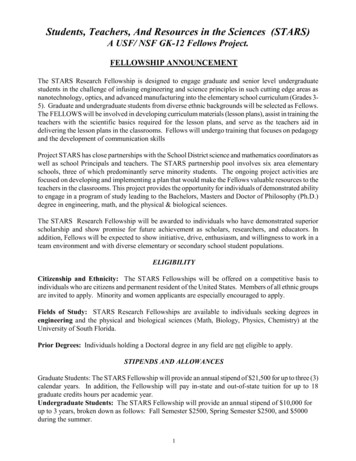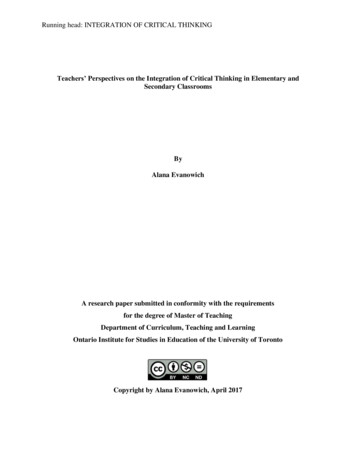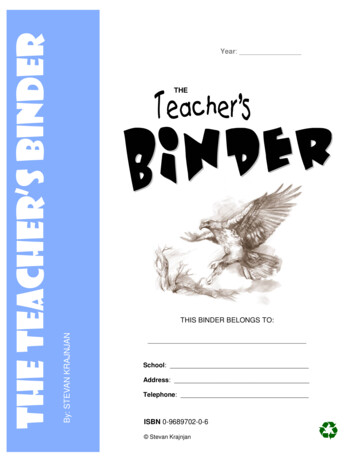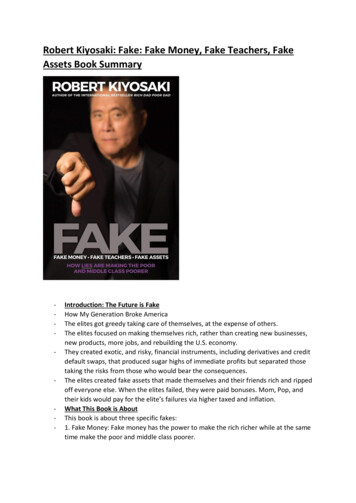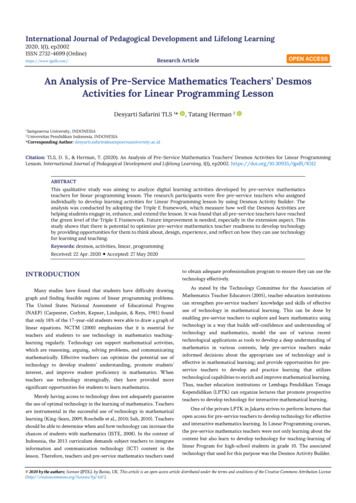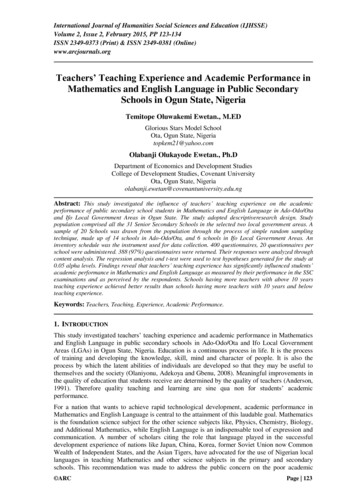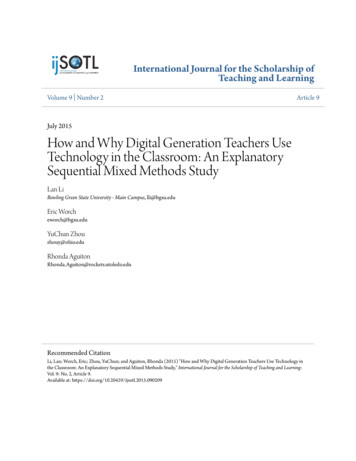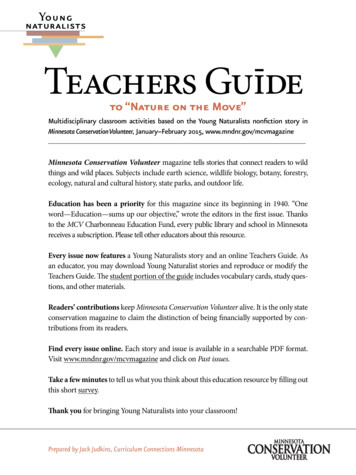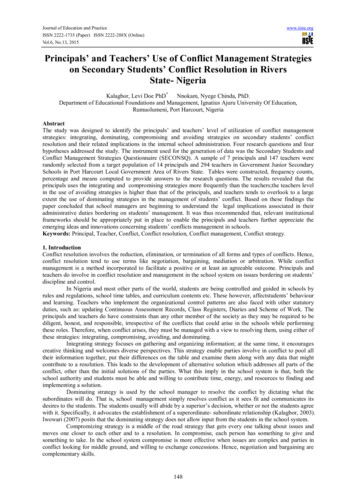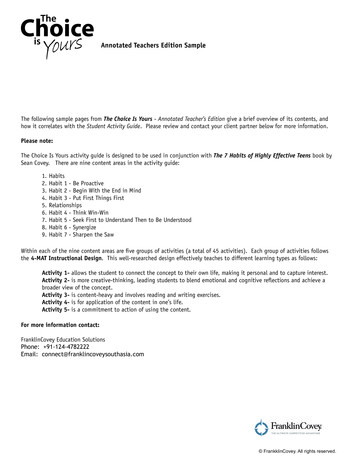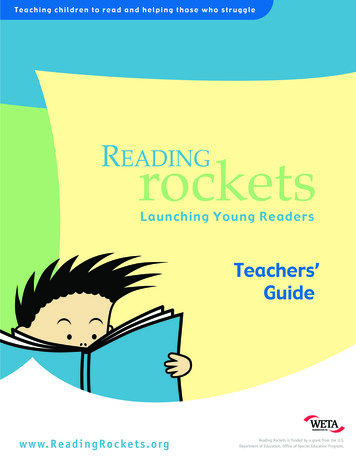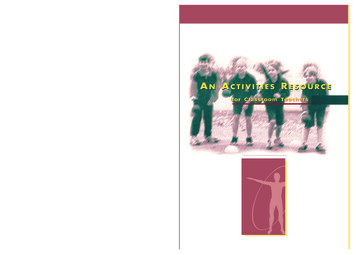
Transcription
TEACHERS’RESOURCESRECOMMENDED FORUpper primary and secondary11 yearsCONTENTS1.2.3.4.5.6.7.8.9.IntroductionPlot summaryAbout the authorAuthor’s inspirationWriting styleKey study topicsKey quotesFurther readingWorksheets1222359913KEY CURRICULUM AREAS EnglishHistory, society and cultureScienceREASONS FOR STUDYING THIS BOOK Story Forms: Rite of Passage/Realistic FictionHow an author constructs voice and characterFirst Person AccountsBuilding vocabularyStructureValues: kindness, fortitude, resilience, braveryTHEMES Identity and Rite of PassagePhysical Deformity and Self-ImageBullyingKindnessFriendshipLoss and GriefPREPARED BYDr Robyn Sheahan-Bright and Random HouseAustraliaPUBLICATION DETAILSISBN: 9780552565974 (paperback);9781448119141 (ebook)These notes may be reproduced free of charge foruse and study within schools but they may not bereproduced (either in whole or in part) and offeredfor commercial sale.Visit www.randomhouse.com.au/teachers forinformation on other Random House Australiateachers’ resources and great books for theclassroom.Copyright Random House Australia 2013WonderR.J. PalacioINTRODUCTION‘My name is August, by the way. I won’t describewhat I look like. Whatever you’re thinking, it’sprobably worse.’ (p 3)August Pullman is different, which is a classic themein children’s and YA literature. But Auggie has a realproblem because his facial deformities make himlook very different indeed. People have to look veryhard to see beyond Auggie’s face, and to appreciatethe person he is inside.His story of going to school for the first time, afterbeing home-schooled for years, coincides with hiselder sister Via going to high school. Bothexperience major emotional changes, and theirfamily dynamics change as well.
Wonder R.J. PalacioThe story is told in first person by Auggie, but alsoincludes parts told in first person by Via, and theirfriends Summer, Jack, Justin, and Miranda.Auggie’s irrepressible spirit has been nurtured by thelove which has cocooned him all his life. This hasn’tcome without penalties, though, because now he hasto face the world outside that world which has beenconstructed by his family, in which neighbourhoodfriends, and those who’ve given him medicaltreatments, have offered him sanctuary, and they allknow that this new world won’t be quite as kind tohim. Fortunately, love, and a sense of humour helphim through some of the darkest times.‘I mean, I don’t want to brag or anything, but I amactually considered something of a medical wonder,you know.’ (p 130)ABOUT THE AUTHORRJ Palacio lives in NYC with her husband, two sons,and two dogs. For many years, she was an artdirector and book jacket designer, designing coversfor countless well-known and not so well-knownwriters in every genre of fiction and non-fiction. Shealways wanted to write, though. She kept waiting forthe perfect time in her life to start writing, but aftermore than twenty years of designing book jackets forother people, she realized that the perfect timewould never really present itself. It's never theperfect time to start writing a book. So she decidedto just go for it. Wonder is her first novel. See herwebsite: http://rjpalacio.com/AUTHOR’S INSPIRATIONPLOT SUMMARYAuggie is terrified of going to school and facing theinevitably bad reactions from kids and their parents.Even his parents can’t agree on whether it will be agood or bad thing for him. But he does go toBeecher Prep and almost immediately finds a friendin Jack and an enemy in Julian. He is also befriendedby Summer, who shares her lunch table with him.Things seem bearable until he overhears aconversation which plunges him into despair.Meanwhile, his sister Via has started high school andis relishing being anonymous. The trouble is that hertwo best friends, Miranda and Ella, seem to beavoiding her, and she’s not sure what’s going on withthem.Via finds a boyfriend in Justin and understudies toMiranda in the school play opposite Justin as thelead. Auggie makes things up with Jack, and all thekids who were against him gradually come round.The school camp proves a turning point, though, andAuggie finds he has more friends than he knew.On her website there is an insightful FAQ sectionwhich answers a lot of the questions you might haveasked RJ Palacio yourselves.Some of her inspiration can also be found in theinterviews below:1.Hodgson, Heather ‘Interview with RJ Palacio’Daily author-of-Wonder.html2.‘RJ Palacio in interview with Chip Kidd,designer, Random House’http://www.youtube.com/watch?v -author-of-Wonder.html3.The book has also engendered the ‘ChooseKind’ campaignhttp://choosekind.tumblr.com/Everything is changing, and neither knows if it’sgoing to be for the better.There’s so much more at randomhouse.com.au/teachers
Wonder R.J. PalacioWRITING STYLE5.Alternative First Person AccountsThis is August’s story, but it actually consists of sixdifferent characters telling their versions of it in firstperson: Part 1 (p 1): August; Part 2 (p 80) Via; Part 3(p 118) Summer; Part 4 (p 133) Jack; Part 5 (p 186)Justin; Part 6 (p 205) August; Part 7 (p 235) Miranda:Part 8 (p 249) August.Such alternating accounts offer an interestingperspective on the action, and in this case, make thisa more subtle and complex rendering of the traumaAugust has endured as a result of his geneticdeformity. The first person voice always lends anempathy and an immediacy to the action, since thereader is given insight into the feelings of thoseinvolved in a series of events. But here we are alsooffered the perspectives of others who have sufferedas a result of August’s affliction as well. Everyonehas a story . and everyone has issues.Activities1.Within these parts, there are a number ofsections told in different types of literarytext. For example, The chapter headed‘Letters, Emails, Facebook, Texts (pp 160-7)includes Jack’s letters of apology to MrTushman and Julian; Mr Tushman’s reply; aletter to Mr Tushman by Julian’s mother(Melissa Perper Albans); Mr Tushman’s replyto her; John and Amanda Will’s reply toMelissa Albans; messages between Jack andAuggie. Discuss the use of such differentforms and how they enhance the framingfirst person narrative.2.Justin’s Part Five is written entirely withoutcapitals for sentences (pp 186-204). Why doyou think this is?3.Re-write a section in the novel in MrTushman’s voice.4.Until the end of the novel, we don’t knowwhy Miranda has been acting the way shehas. Write a chapter in Ella’s voice and try toimagine a scenario which has made her turnaway from Via.Verse novels offer a very immediate form ofpersonal writing. Write a sequence in thenovel as if it is a poem in a verse novel.(Study some contemporary verse novels inorder to prepare for this exercise.)Questions1.Why do we not hear from either of Auggie’sparents? Listen to RJ Palacio’s interviewwith Chip Kidd (listed above) after you haveanswered this question.2.Which other character in Auggie’s classwould you like to have heard from?Literary Devices and SymbolsThis novel employs a range of literary devices andsymbols to cement themes. Devices such as simile,metaphor and personification are used to describethings in a more obtuse way than is possible whenusing literal language or description. Symbols canalso be used to denote something in a moresuggestive fashion. Some of the various types ofliterary language used in this novel are discussed inthe points below.Activities1.Part Two is Via’s view of the situation. It openswith a quote from David Bowie’s ‘Space Oddity’and then a chapter headed ‘A Tour of theGalaxy’, and continues to employ metaphors ofspace and planets to describe the familysituation. She suggests that Auggie is the sunand that she and her parents are like planetsrevolving around him. She ends by saying: ‘Thegalaxy is changing. The planets are falling out ofalignment.’ (p 83) How does the use of suchmetaphor enrich the reader’s understanding ofthis situation? Would it have been less effectiveif she had simply described her home life incompletely realistic terms?2. Mr Browne’s ‘Precepts’ are discussed (pp 45, 48).On p 65 Auggie writes a piece on beingremembered for the things we do. Invitestudents to write a piece based on this, or anyother precept included in the book. On p 288,Mr Browne writes his last precept at the end ofterm, and on pp 311-13 the precepts are listedand also the postcards that kids send Mr Browneover the break. Write a postcard to Mr Brownecontaining your favourite precept.3. Part Three opens with a quote from ChristianAguilera’s song ‘Beautiful’. Part Seven quotesThere’s so much more at randomhouse.com.au/teachers
Wonder R.J. PalacioAndain’s ‘Beautiful Things; Part 8 quotesEurythmic ‘Beautiful Child’. Discuss ‘beauty’ inrelation to physical and moral or mentalattributes. There is a touching scene where Nateconfesses to Auggie that he threw out theastronaut helmet because he missed looking athis face. ‘I love this face of yours, Auggie,completely and passionately.’ (pp 290-2) Howshould beauty be defined?4. Identify any other literary devices (e.g.Personification/ simile/ metaphor) used in thenovel. e.g. ‘Like I had my own emperor’s guard’ (p272).Christopher Nolan’s Under the Eye of theClock (p 300). Discuss these quotes.Questions1.Auggie and Nate have fun reciting the linesfrom a favourite song The Luckiest Guy onthe Lower East Side written by StephenMerritt and performed by The MagneticFields (pp 289-92). What does this songmean to them?2.What literary reference or quote had mostresonance for you?Questions1.2.Were there any literary devices whichseemed most evident in this text?What symbols or motifs did you notice inthis text?Literary, Film and Popular CultureReferencesCharacterisationAugust, his sister Olivia (Via), his parents Nate andIsabel Pullman are a loving family with a muchloved dog named Daisy. When the two siblings go tonew schools, though, Via’s old friendships are tested,and Auggie finds new friends, and new enemies.Activities1.Each part opens with a quote and there are manyreferences to literary and film texts.Activities1.2.3.4.5.Discuss one of these quotes in relation tothe section which follows. e.g. Part Fouropens with a quote from Antoine de SaintExupery’s The Little Prince. Discuss inrelation to Jack. Part Five refers to BernardPomerance’s The Elephant Man; Part Six isShakespeare’s Hamlet. How do these relateto the action thematically?Identify any other quotations referred to oremployed in this novel.Star Wars is Auggie’s favourite thing, and thenovel is littered with references to the filmfranchise. How do the characters andthemes of Star Wars relate to the actionsymbolically? Identify any other literarydevices (e.g. Personification/ simile/metaphor) used in the novel. e.g. ‘Like I hadmy own emperor’s guard’ (p 272).He also refers to The Lord of the Rings, andIsabel is reading The Hobbit to him. He laterreads CS Lewis’s Narnia series, and on p 273there is a quote from it. Discuss the latterand its significance.Mr Tushman’s speech refers to JM Barrie’sThe Little White Bird (p 299) and to2.3.4.Julian is an unlikeable character. What doyou think has influenced his developmentinto such a mean and unthinking bully? Ismoving to a new school likely to improvehim?How does dialogue inform character in thisnovel? Choose a passage and detail what ittells you about the characters speaking toeach other.Trace a character arc for one of thecharacters showing the various changes inthat character.Describe one of the characters in your ownwords.Questions1.Which character did you engage with mostand why?2.Which did you like least and why?There’s so much more at randomhouse.com.au/teachers
Wonder R.J. PalacioStructure and Suspensetaunting Jack is a ‘slapstick’ joke or incident(p 199). What does ‘slapstick’ mean?3. Sarcasm is often used as a form of selfdefence, but it is a form of humour whichcan also be very hurtful. Locate examplesof sarcasm in the book, and how thecharacters respond to it.An author creates structure in a work by plotting andplanning, and ensures thematic cohesion byintegrating stylistic details into this overall plan.This novel (like many prose narratives) is arranged asa chronological sequence of events, but alsocontains flashbacks which inform the action.ActivitiesQuestions1.The opening and closing sentences of achapter are very important in terms ofmaintaining tension and engagement withthe reader. Choose examples in the bookand how they work to maintain suspenseand interest. e.g. Opening: ‘I was reallybummed when Christopher moved awaythree years ago.’(p 8) Closing: I wanted ahole I could fall inside of: a little black holethat would eat me up.’(p 78)2. Create a Book Trailer based on the novel’sstructure. View some of the other BookTrailers based on the book on both theauthor’s and publishers’ websites, and thosecreated by students, which are available onYouTube.3. Create a timeline detailing the eventsdescribed in the novel. Begin with Auggie’sbirth and mark on the timeline the eventswhich you consider to be thematicallysignificant.What are the major themes in the novel, andhow do they influence the structure?2.What other devices does the author use tomaintain suspense?3.Imagine if there were a sequel to this novel.What might happen in it? Or do you thinkthat the ending is all that the story needsand that a sequel would spoil it?Humour2.What was the funniest scene?Several social topics are raised in the book. Studentsmight further examine any one of them.Identity & Rite of PassageEach of the characters in this novel mature in certainways, and Auggie’s problems assist them in doing so;they also help Auggie to gain in maturity.Activities1.‘You can’t blend in when you were born to standout’ is written on the cover of this book. Watchthe Book Trailer for th
Wonder R.J. Palacio There’s so much more at randomhouse.com.au/teachers WRITING STYLE Alternative First Person Accounts This is August’s story, but it actually consists of six different characters telling their versions of it in first
